Fungi from leg nails or virulence is a common problem and everyone risks their lives regardless of age or social status.The disease is accompanied by extremely unpleasant symptoms associated with aesthetic changes in nails and physiological discomfort.
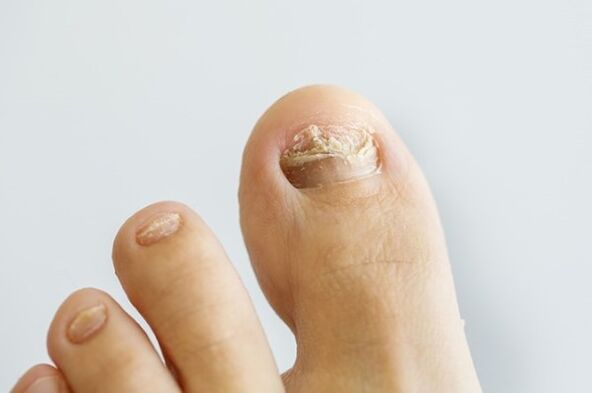
Causes of fungal nail damage
Fungal damage to legs is more common in medical practice than similar diseases on hands.This is due to the greater frequency of contact between the lower limbs and the contaminated environment.In this case, the main reason for this is to reduce immunity.Weakened organisms cannot fully withstand infectious agents.
If we talk specifically about fungi on the legs and nails, there are many factors that can cause infection:
- Go to visit public places without shoes.This is especially true for bathrooms, saunas and swimming pools, gymnasiums or showers in production, hospital departments.In the first two cases, the risk of infection is high because it is a carrier of fungal infection.In addition, mushrooms breed more actively in humid environments.Despite complying with hygiene standards, hospitals include places for various infections of fungal infections.After barefoot on the floor in one of these places, the chance of infection has increased tenfold.
- In the absence of regular cleaning of aggressive chemistry, its own bathroom also becomes a seedling of fungal infection.Even if no one in the household suffers from dinoflagellate disease, conditionally pathogenic mushrooms on human skin breed in an uncleaned bathroom.Increased population can lead to regrettable consequences.
- Wearing conditional pathogenic mushrooms wearing old or other people’s shoes, their shoes (especially closed-end) are inevitable.Microorganisms accumulate in the tissue layer, which also increases the risk of infection.
- Wearing shoes is not seasoned - One of the factors that are infected is excessive sweating on the legs.If a person wears closed shoes in the summer or warm shoes in the room, the possibility of fungal damage increases.
- Violation of leg hygiene - Many people do not pay proper attention to lower limb hygiene.However, regular cutting of nails and washing hands with a lot of soap is not enough.It is important to cut your nails regularly, cut burrs and push out the cuticle, use a special lotion and continuously cleanse the cuticle of your skin.
- Injury - We are talking about the damage to the nail plate with brush strokes, bruises, cuts.In this case, blood circulation is disturbed in the damaged area and the nails are not properly nourished.This may cause fungal development.
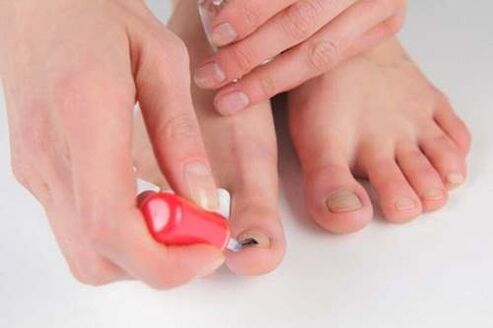
Fun types and characteristics of nail damage
Characteristics of treatment depend on identifying mushroom species that affect the nail plate.This is due to the possibility of the selection of drugs associated with a specific type of pathogen and the implementation of the most effective treatment.
Skin Plants
The most common type of pathogen.According to statistics, skin plants cause fungi to about 75-80% of cases of nails.In this case, the state of the immune system plays a major role in the occurrence of dinoflagellosis.Through normal immunity, fungal damage to skin plants is almost impossible.
Infect humans or animals from vectors, and contact with soil.Ceratinouttes, the cellular structure of the epidermis (high content observed in the nails) is a favorite medium for this mushroom’s nutrition.
Two major subspecies are distinguished in the caste of skin plants, the most common being the Aschomycisosis pathogen:
- Red trichophyte (rubrum) - The beginning of the pathological process occurs at the end (external or free) part of the nail, from which the infection gradually moves to the root of the nail plate.In most cases, this subspecies affects the toes.His features are the nails that have been damaged simultaneously on several fingers (usually standing nearby).The characteristic signs of infection are the thickening and stratification of the nail-affected area.The skin below the outside of the nail plate is dry and the peel.
- Trimacosmona plants are graduate students - in this case, white surface myomyces disease occurs.The favorite habitat of the subspecies is wet and is usually found in bathrooms, bathrooms, swimming pools.The etiology affects the thumbs of the lower limbs more and then "captures" other nails.Feature features are considered as focal damage to the nail plate, with the appearance being a separate white dot or bar.In the future, the white areas will continue to grow and merge together.When the fungal lifespan form is spread over other fingers, the dry and peeling areas between the fingers are found.
Yeast
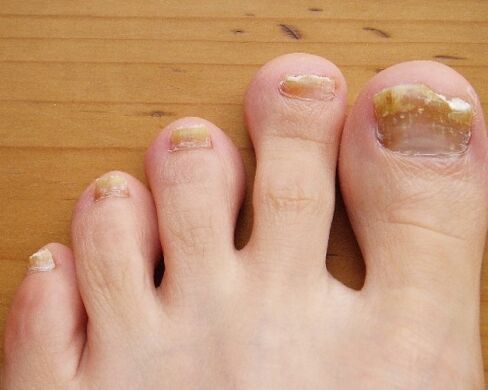
Another pathogen that fungi damages leg leg leg is conditionally pathogenic mushrooms from the Candida family.Because they continue to live on the surface of human skin, they are considered traditionally and pathogenic.That is, for infection, contact with infected people, animals or external environment is not necessary at all.In this case, the main trigger for pathology is immunity, a significant reduction in immune deficiency.
Unlike skin plants, yeast mushrooms do not form a layer of mycelium, i.e., it is much less frequently destroyed with this damage form of nail plate.However, the same factor makes the infectious lesions worse because the beginning of the pathological process occupies the root (proximal end) of the nail.This ending variant is considered more serious, but is rare at the same time.
The first characteristic of the pathological process caused by yeast mushrooms is the detachment of the upper layer of the nail plate.As a result, the nails lose their luster and become dull and rough.In about 7-10% of cases, damage to nails occurs with yeast mushrooms.
Molds
The most sinister mushroom types, as these life forms are found almost everywhere (but especially in wet environments).Fungal damage to the nails on the legs can cause approximately 35-40 mold subspecies.
Although the prevalence in the environment is high, this form of octa-strepcoccal disease is rarely diagnosed.Therefore, to some extent, mold is more difficult to diagnose and treat due to atypical clinical conditions.Another reason for the complexity of diagnosing mycelial complex is the ability of mold to form mycelium, which makes the clinical image a picture of damage to skin plants.
Fungal life span forms mainly affect nails on the legs, while subspecies infection is about 10-15%.
Clinical Pictures
Most fungal damage to the nail plate progresses slowly.In the initial stage, the fungus simply did not notice it.However, it is important that symptoms remain in the early stages of pathological development.
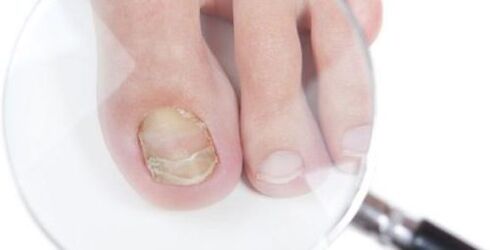
- Invasion of growth is the first and least conspicuous sign.Under the standard state, the nails on the legs will not grow more than 2 mm per week.Fungi-affected nail plates reduce growth rate.
- Change color - First, the nails affected by the fading of fungi lose their luster and turn into matte.It also points to the appearance of white or yellow spreading on the nail surface, or completely changing on the color of the nail plate (shades of white, yellow or brown).Change the color from the nail fungus in the picture above.
- The formation of burrs and damage to the stratum corneum are another indirect property that indicates fungal lesions in nearby skin.If burrs begin to appear more frequently and the stratum corneum region system is inflamed or damaged, it is worth checking for fungal lesions.
- Thickening or thinning of the nail plate - The variation depends on the specific type of damage to the mushroom.
As the pathological process develops, the symptoms become more and more obvious, and it is difficult to ignore it.Clinical signs in the late stages of tumor disease include:
- Changing the surface of the nail plate - becoming rough and uneven, dotted with nodules and waves.Also on the nails, a similarity of bread crumbs may occur, which indicates a gradual separation of the upper layer of the nail.
- In the later stages, the nails gradually begin to collapse.Initially, this is expressed in the layering of the nail plate, the appearance of the cracks on the entire surface or the chip at the outer edges.This is what this characteristic of the fungus in the photo looks like.
- In the future, the damage will be even worse.Nails are actually collapsed and don't have time to grow.Meanwhile, the sub-segment portion of the dermis is exposed, while the rest of the nail is obviously painful and unattractive.As a result, there is a risk of total damage or disengagement from the nail plate.Severe lesions with nail fungus in the photo above.
The dangers of complications
Many unpleasant feelings and worsens in the appearance of the legs and nails are just the top of the iceberg.The lack of timely treatment threatens the development of complications, the most common of which is:
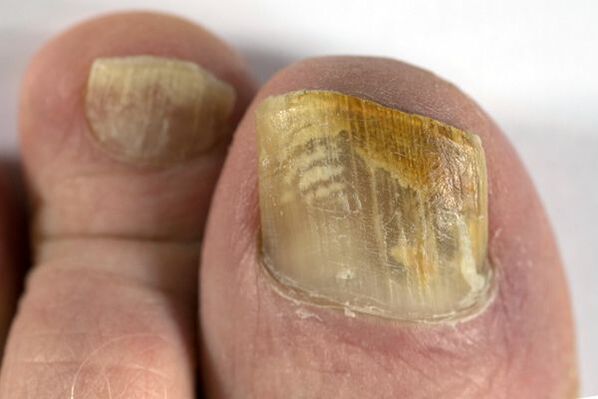
- Anaphylaxis - At certain stages of development, the body can regard the fungi in the legs as an allergen.
- Fungal damage can weaken the body's immune system and cause the development or development of a variety of diseases (including systemic diseases).
- The lack of treatment for thyroxine disease allows other infections to be added to affected areas.As a result, inflammation and purulent processes develop as well.
- Extremely severe cases, affected by the long-term course and progression of the disease, may lead to the development of fungal and mycotic diseases.In this case, fungal life forms can penetrate the blood and be spaced in the entire body.
Treatment Methods
To maximize the effectiveness of leg nail fungi, complex therapies are often used.Meanwhile, it was previously important to make the diagnosis by sowing on the bacterial environment to determine the type of pathogen and select the most effective drug.Comprehensive approach involves a combination of several types of treatments, but sometimes this is not enough.
Medicine
Drug therapy is the basis for the treatment of most pathology, including fungal nail lesions.As part of the treatment, two main drug groups were used according to the development stage of the pathological process:
- Topical types of effects - which include ointments, gels, varnishes, creams, sprays and lotions with antifungal activity.The method of using such drugs, the multiplexity and duration are determined by the doctor, but in most cases they are used for at least 2-3 weeks.
- Systemic antibiotics - is necessary for the treatment of nail fungi at the later stage of progression.In most cases, these are tablets, which, after sucking from the gastrointestinal tract, can penetrate the blood and inhibit fungal life forms, and also do not allow mycelium to spread.The use of the system is important not only for enhancing the therapeutic effect, but also for the purpose of preventing recurrence.
Folk therapy
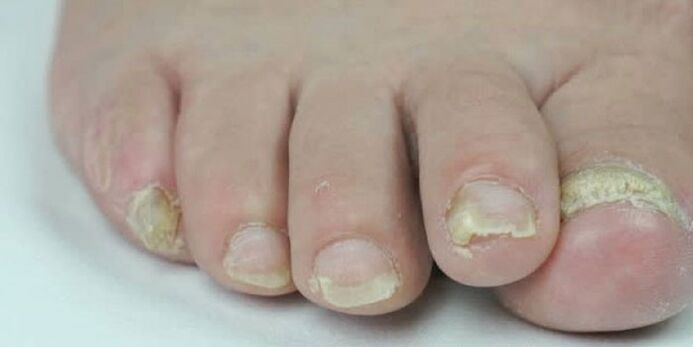
Traditional medicine is considered an auxiliary method to combat fungi on the legs.Folk recipes can enhance antifungal effects.The most effective ones consider:
- Iodine - able to dissolve protein structures, which is the basis of fungal life forms.For daily treatment, apply a few drops of iodine onto the affected area with a cotton pad.
- Peroxides are effective antibacterial agents with disinfection effects.To enhance the effect, the peroxide and vinegar are mixed in equal proportions.The patient is then lubricated with the mixture without rinsing.The process is repeated for 1-2 weeks a day.
- Celandine - The best way to treat fungi on leg nails using this plant is housework.To do this, take a tablespoon of crushed raw materials (leaf and branches), pour 0.5 liters of water and bring to a boil.The soup defended within 15-20 minutes, and then the legs were inserted for 20-25 minutes.Repeat the operation for 2-3 weeks every day before going to bed.
Removing nails
Nowadays, in medical practice, the chemical method of using nail boards is mainly used - use avoided.To do this, special aggressive medications were used, and the surgery was performed by a doctor to avoid damaging the healthy areas of the nail plate and skin.The method is painless and effective, and the indications used are the results of lack of conservative treatment or advanced treatment cases.
Laser Therapy
This process involves partial or complete removal of the nail plate.The choice of this method depends on the depth of the fungus penetrates into the nail structure.During the laser therapy process, a dense laser irradiation method is used.Use the fungal layer of the nail to remove special equipment and then perform antifungal therapy.
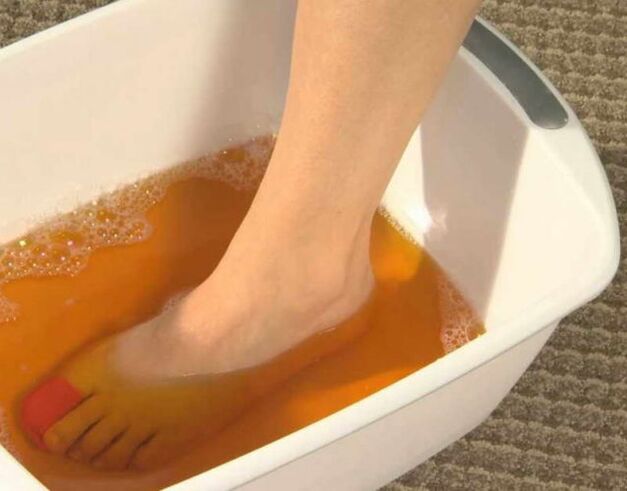
If the nails are completely affected by fungi, you need to completely remove the nail plate with a laser.In this case, after removal, a bandage is applied to the exposed area of the skin, under which a cream or cream with antifungal effects can be placed.Removing the nail plate requires regular visits to the doctor to season and monitor the growth of new nail plates.
Laser treatment of nail fungi on the legs, during which time, only a few layers of nails were performed (about 10-15 minutes on each nail) over 7-10 processes.If removal is shown, the process disappears for about 20 minutes and the patient does not feel pain.

















